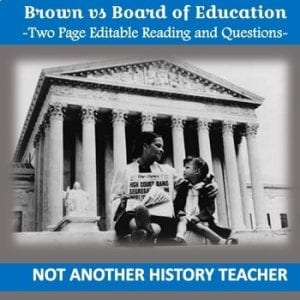One of my favorite units to teach about is World War II. I love showing how the US was able to enter the war and how the effects of the war are still very much present today. I love teaching with this World War II homefront stations lesson. With this fast 55 minute lesson kids are engaged in a variety of resources on the US homefront from rationing to women entering the workforce, to Japanese discrimination to African American enfranchisement. My kids ask for stations since the class period  seems so different. They are engaged in primary sources, World War II posters, and videos on the homefront in one class day if you are teaching a survey course it is very helpful.
seems so different. They are engaged in primary sources, World War II posters, and videos on the homefront in one class day if you are teaching a survey course it is very helpful.
The World War II Escape Room will take students on a secret mission around the classroom! This escape room has students decode interesting facts about World War II. This is the perfect resource to introduce or review FDR, Pearl Harbor, Hitler and the Holocaust. The World War II Escape Room has students walking around the classroom breaking codes. Students are given a secret code name and sent on a secret mission to restore Anne Frank’s Diary. The codes include ciphers, Morse code, cryptograms and a final 4 digit code based on the decoders/clues.
These World War II sensory figures can be printed in black and white or color, and the set includes the seven most prominent leaders of World War 2. A sensory figure is a drawing of a historical, living, or fictional figure with first-person descriptions of what they might have thought, seen, heard, touched, said, felt, or otherwise experienced during their lifetime. Students “show what they know” about the figure by writing 1-2 sentence descriptions for their figure’s thoughts, feelings, and actions. After writing the descriptions, students connect them to the part of the body to which it most closely relates. For example, a feeling might be connected to the heart. The descriptions should be specific to the historical figure’s life, not generic statements that could apply to anyone. Students should be encouraged to address several topics in their descriptions instead of repeating information.
This World War II Documentary activity allows each student to become an expert on one topic from WWII. They create a 2 minute video clip with footage and voice-overs to explain the topic. All clips are then combined into one large documentary that covers World War II. In this resource, you receive the project sheet, participation and overall rubrics, suggested topic sheet, and research graphic organizer.
18+ ready-to use digital notebook pages on World War II are great for your World War 2 unit. Students learn about and analyze topics related to World War II such as leaders, the Allies and the Axis, and the Japanese internment camps
I am not a fan of military history so I teach the battles using this two page handout about the key turning points of WWII in a graphic organizer. Students can complete this with the internet or with a textbook. It is a nice review of a unit or reinforcement of key concepts.
Here are some wonderful resources that are free!!!
 This is a jigsaw lesson on the causes of the American revolution. It is a graphic organizer with reasons and reactions from the American and British perspective. I put my students into groups they read a short reading about their assigned cause, complete the assigned section on the chart, and then teach the class about their topic. This assignment was created in Word and can easily be adapted and modified for your classroom.
This is a jigsaw lesson on the causes of the American revolution. It is a graphic organizer with reasons and reactions from the American and British perspective. I put my students into groups they read a short reading about their assigned cause, complete the assigned section on the chart, and then teach the class about their topic. This assignment was created in Word and can easily be adapted and modified for your classroom.


 seems so different. They are engaged in primary sources, World War II posters, and videos on the homefront in one class day if you are teaching a survey course it is very helpful.
seems so different. They are engaged in primary sources, World War II posters, and videos on the homefront in one class day if you are teaching a survey course it is very helpful.





 also an extra two page homework assignment if they finish a station early. Stations lesson includes coloring, notes, cartoons, video, and primary documents.
also an extra two page homework assignment if they finish a station early. Stations lesson includes coloring, notes, cartoons, video, and primary documents.